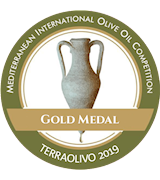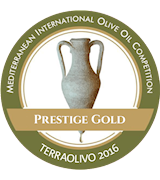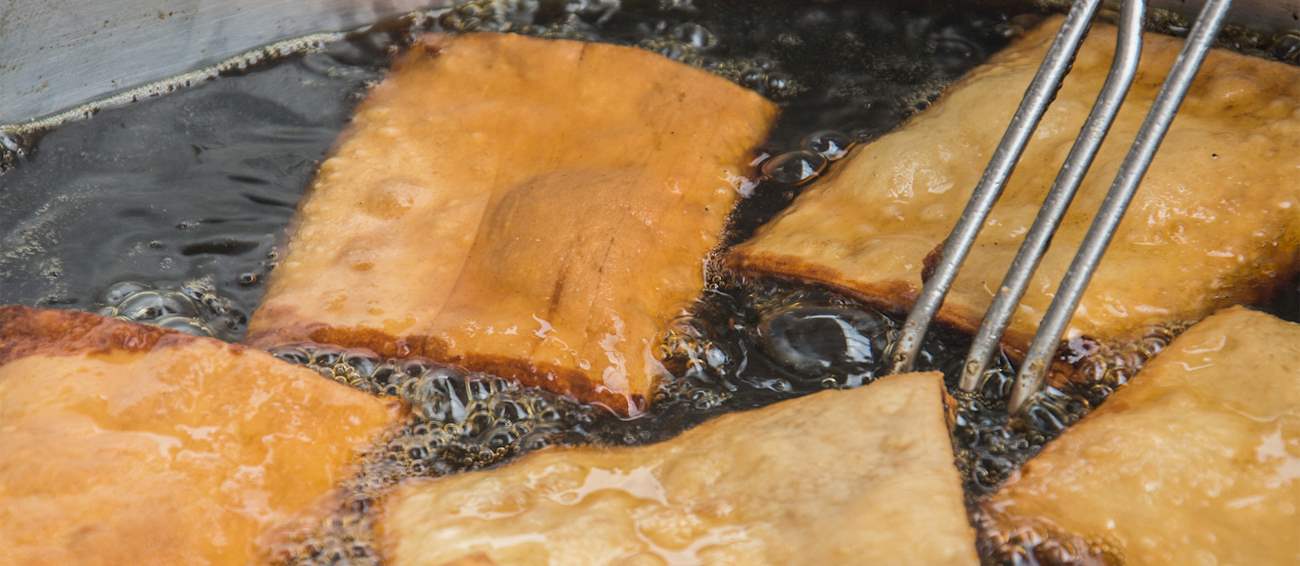TABLE OF CONTENTS
Best Maltese Foods
Pastizz is Malta's national snack, a phyllo pastry filled with ingredients such as peas, ricotta, anchovies, corned beef, or apples. The thin dough is stretched and rolled with layers of fat in between, which is used to achieve the typical flaky texture of the finished product.
The dough is then filled with any of the aforementioned ingredients, shaped into diamonds or semicircles, then baked until golden brown. Pastizzi can be consumed as a snack or served as appetizers in bars.
Imqaret is a traditional pastry that is filled with a combination of dates, citrus, and spices, shaped into a diamond, then deep-fried in hot oil. The name of the dish is derived from the word maqrut, meaning diamond-shaped, referring to the visual appearance of this flavorful pastry, although it may also be shaped into rectangles in some cases.
Imqaret is often dusted with powdered sugar, and it is sometimes paired with a scoop of ice cream on the side.
Fenkata is the national dish of Malta, a communal meal that is prepared with rabbit as the star of the feast. A whole rabbit is typically marinated in wine, then stewed with aromatic herbs and vegetables such as carrots, tomatoes, onions, and garlic until tender.
The sauce should be rich in flavor and thick in texture. It is recommended to serve fenkata with pasta (usually spaghetti) or potatoes, while olives and capers might also be added to the dish in order to further elevate its flavors.
This open-faced Maltese sandwich translates as bread with oil. It is made with slices of crusty sourdough bread which are smeared with kunserva (tomato paste), drizzled with olive oil, and then enjoyed with a variety of toppings.
Those traditionally include canned tuna or white anchovies pickled in vinegar, ġbejna sheep cheese, fresh tomatoes, pickled vegetables, bigilla mashed beans spread, onions, olives, and capers. Being Malta’s number one snack, hobż biż-żejt can be found in almost every eatery in the country.
This flat, marzipan-filled Maltese cookie is typically shaped into lambs or bunnies because it is traditionally prepared during the Easter festivities. These sweet treats are often decorated with icing, melted chocolate, or chocolate Easter eggs.
Originally, figolla was made in the shape of fish, baskets, or women, and it symbolized fertility. Regardless of the design, figolla is a staple of Maltese pastry shops and home kitchens around Easter.
This flavorful Maltese dish is a baked pasta casserole that is typically made with penne or rigatoni. Although the recipe was inherited from Sicily, imqarrun il-forn is nowadays a staple of Maltese cuisine. Besides pasta, the casserole is made with ground meat, onions, carrots, garlic, tomatoes, eggs, cheese, and flavorings such as nutmeg, curry powder, or bay leaves.
Baked until golden-brown in color, the dish should be crispy and crunchy on the exterior and moist on the inside. It is often served as a part of Sunday lunch on Malta.
Ġbejna is a small cheeselet produced from sheep or goat milk, rennet, and salt. The cheese can be prepared in numerous ways – salted, peppered, pickled, covered in herbs, or plain. It is believed that Ġbejna was originally prepared with seawater instead of rennet as a curdling agent.
Nowadays, the cheese is a staple of Maltese cuisine - it can be used in a traditional Maltese soup called soppa tal-armla, served with local sourdough bread for breakfast, or paired with dips and spreads in Maltese appetizer platters. Many Maltese restaurants have recently employed the practice of using this cheese instead of ricotta in the preparation of a traditional filled pastry known as qassatat.
Pair with
Prepared in many shapes and in numerous local variations, this sourdough bread is a staple of almost every Maltese kitchen. It is typically baked in wood-fired ovens and consists of flour, yeast, water, and salt. The bread is usually served as an accompaniment to a variety of dishes, but the most popular way of consuming it is to rub it with tomatoes, drizzle it with olive oil, and top it with ingredients such as cheese, olives, capers, onions, or fish.
MAIN INGREDIENTS
Bigilla is a broad bean dip originating from Malta. It is usually eaten as a snack or a spread, served with Maltese crackers called galletti, or toasted sourdough bread. Soaked and boiled dried tic beans—ful ta’ Girba are mashed with garlic, parsley, and olive oil into a paste seasoned with salt and pepper, which can optionally be flavored with chili, lemon juice, and various herbs.
Similar to another Maltese delicacy known as pastizzi, qassatat is a delicious pastry filled with a variety of different ingredients, even though ricotta cheese is the most popular choice. These pastries are so popular that they are one of the most consumed street food items on Malta.
The dough consists of flour, butter or olive oil, eggs, salt, and water, while the ricotta filling may be additionally enriched with raisins, onions, or fava beans. Apart from ricotta, other varieties of qassatat include ingredients such as spinach, capers, peas, olives, and anchovies.
TABLE OF CONTENTS
Best Maltese Food Producers
The Mediterranean Culinary Academy (MCA), based in Malta, is dedicated to advancing Mediterranean cuisine and promoting sustainable agricultural practices. They offer a range of cooking classes suitable for all levels, providing students with the technical abilities to excel in any culinary role.
In collaboration with the Grima family, MCA produces Bidni Extra Virgin Olive Oil, derived exclusively from the indigenous Bidni olive variety. This monovarietal oil is celebrated for its unique flavor—spicy, aromatic, fruity, with a peppery bite to finish.
Cottage Products (Gozo) Ltd. is an olive oil producer based in Xewkija, Gozo, Malta. The company is known for producing high-quality extra virgin olive oil using locally sourced olives. They implement traditional pressing methods to maintain the natural flavors and nutritional benefits of the olives.
The company also engages in sustainable farming practices to ensure environmentally friendly production.
AWARDS

Terraolivo IOOC - Gold Medal
2019, 2015

Terraolivo IOOC - Prestige Gold
2016
BEST Gozo Cottage Olive Oils
Savina is a renowned Maltese brand known for producing high-quality gourmet products, including olive oil, olives, and other specialties inspired by Mediterranean tradition. Based in Malta, this brand is part of the Magro Group, one of the island's oldest and most prestigious companies, recognized for its commitment to quality and preservation of local heritage.
The products are inspired by Malta's rich cultural heritage and Mediterranean flavors. Savina not only promotes local ingredients but also contributes to preserving traditional preparation methods.
AWARDS

IWSC- International wine & spirit competition - Spirit Gold
2023
BEST The Guard Limited Spirits
San Niklaw Estates is a family-owned estate located in the southeastern part of Malta, near the town of Żejtun. The estate encompasses vineyards, an olive grove with over 400 olive trees, and a winery with a cellar dating back to the 19th century.
The olive grove consists of indigenous trees as well as varieties such as Frantoio, Carolea, Coratina, Ascolano, and Bella di Spagna. Harvesting is done by hand in October, and processing takes place immediately on the estate using modern Italian equipment.
The combination of different varieties results in fresh, fruity olive oil that reflects the unique character of the local soil.
BEST San Niklaw Estates Olive Oils
Cassar Camilleri is one of the oldest and most prestigious Maltese companies, established in 1901. Over more than a century, the company has evolved into a leader in the production and distribution of high-quality food and beverage products in Malta.
Their dedication to excellence, innovation, and the preservation of traditional values has made them synonymous with quality in the industry. Cassar Camilleri is renowned for its range of wines, liqueurs, and olive oils. Their extra virgin olive oils are made from carefully selected olives, processed with great care to preserve their natural aroma and nutritional properties.
These oils are the perfect choice for lovers of authentic Mediterranean flavors.
BEST Camilleri Wines Olive Oils
Marsovin is a distinguished Maltese wine producer with a rich heritage dating back to 1919. Founded by Chevalier Anthony Cassar, the company has evolved over generations, achieving renown among the Maltese people for the quality and variety of its range of wines, as well as for its pioneering success on both local and international fronts.
Marsovin owns over 199 tumuli of land, comprising five private estates across Malta and Gozo, dedicated to producing premium quality, single-estate wines. Their cellars, situated in a historic building dating back to the Order of St. John, house over 220 oak barrels used for aging premium red wines.
BEST Marsovin Winery Olive Oils
Golden Extracts is a prominent Maltese producer of premium extra virgin olive oil, operating from the Tal-Kancillier Olive Oil Press located beneath the Mdina bastions. Their olive grove, established in 2002, comprises approximately 650 trees, yielding around 2,000 liters of high-quality olive oil annually, marketed under the Melite brand.
Equipped with state-of-the-art extraction machinery, Golden Extracts offers pressing services to third-party growers, processing both commercial and smaller lots during designated 'Community Days.
BEST Golden Extracts Olive Oils
TABLE OF CONTENTS
Best Maltese Food Products
Bidni Extra Virgin Olive Oil is a premium artisanal product created through the collaboration between the Mediterranean Culinary Academy (MCA) and the Grima family. It is exclusively derived from the indigenous Bidni olive variety, a rare and ancient cultivar native to Malta.
Known for its robust flavor and health benefits, this olive oil has gained both local and international acclaim.
AWARDS

London IOOC - Platinum
2023
AWARDS

Terraolivo IOOC - Gold Medal
2019, 2015

Terraolivo IOOC - Prestige Gold
2016
AWARDS

EVO IOOC - Gold Medal
2018
AWARDS

IWSC- International wine & spirit competition - Spirit Gold
2023
Savina Extra Virgin Olive Oil with Rosemary & Thyme is a carefully crafted gourmet product that combines the rich, fruity taste of high-quality extra virgin olive oil with the aromatic notes of rosemary and thyme. This unique blend brings an authentic Mediterranean character, perfectly enhancing a variety of dishes with its fragrance and freshness.
It is ideal for use as a finishing touch on roasted meats, vegetables, or pasta, as well as for marinating or preparing bread with oil and herbs. The product reflects a dedication to traditional techniques and local ingredients, making every meal a special delight.
Savina Cracked Pickled Olives in Olive Oil are carefully prepared olives that combine traditional processing methods with the rich flavor of Mediterranean olive oil. Each olive is hand-selected and gently cracked to allow the marinade to infuse deeply, creating a perfect balance between the tangy notes of pickled olives and the smooth, fruity texture of olive oil.
This product is ideal as an appetizer, a salad topping, or part of a cheese and charcuterie board, bringing the taste of the Mediterranean to every bite. Made with respect for tradition, it offers a perfect blend of flavor and quality.
Savina Olives with Chilli and Garlic are carefully prepared olives that deliver the perfect combination of spiciness and aromatic flavor. Each olive is hand-selected and marinated with natural chili and garlic, resulting in a rich and intense flavor profile.
This product is perfect for lovers of Mediterranean delicacies, ideal as an appetizer, a salad topping, or as part of a cheese and charcuterie board. Savina Olives with Chilli and Garlic beautifully blend tradition and authentic tastes, bringing a touch of the Mediterranean to every bite.
San Niklaw Estates Olive Oil is a premium product crafted from a carefully curated selection of olives grown on the estate's 400 olive trees in the fertile lands of Żejtun, Malta. The oil is produced using a blend of both indigenous and renowned international olive varieties such as Frantoio, Carolea, Coratina, Ascolano, and Bella di Spagna.
Harvested by hand in October, the olives are processed immediately on-site using modern Italian equipment to preserve their freshness and rich flavors. The result is a vibrant, fruity olive oil with a distinctive Mediterranean character, reflecting the unique terroir of the region.
The Camilleri Wines Extra Virgin Olive Oil is a premium-quality product crafted with care to deliver an authentic Mediterranean experience. Made from carefully selected olives, this olive oil reflects a rich heritage of traditional cultivation and modern production techniques.
It boasts a smooth, fruity flavor profile with subtle peppery notes, making it ideal for enhancing salads, pasta, grilled vegetables, and fresh bread. This extra virgin olive oil not only elevates culinary creations but also embodies the essence of Mediterranean authenticity, making it a staple for gourmet enthusiasts.
TasteAtlas food rankings are based on the ratings of the TasteAtlas audience, with a series of mechanisms that recognize real users and that ignore bot, nationalist or local patriotic ratings, and give additional value to the ratings of users that the system recognizes as knowledgeable. TasteAtlas Rankings should not be seen as the final global conclusion about food. Their purpose is to promote excellent local foods, instill pride in traditional dishes, and arouse curiosity about dishes you haven’t tried.









































